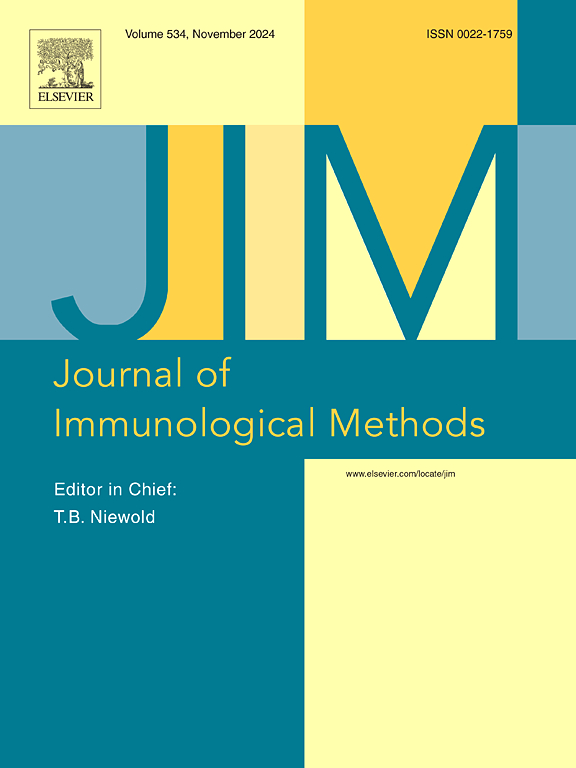Multiplex ACE2-RBD binding inhibition assay: An integrated tool for assessing neutralizing antibodies to SARS-CoV-2 variants and protection against breakthrough infections
IF 1.6
4区 医学
Q4 BIOCHEMICAL RESEARCH METHODS
引用次数: 0
Abstract
SARS-CoV-2 remains a significant health threat due to its high infection and mutation rates. The emergence of new variants of concern poses challenges as they can lead to immune escape mutations, potentially reducing the efficacy of vaccines and antibody therapeutics. The receptor binding domain (RBD) of SARS-CoV-2 is particularly noteworthy as it is both the most rapidly evolving domain and the principal target of neutralizing antibodies. As an alternative to time-consuming and expensive neutralization assays, we have developed a bead-based multiplex surrogate virus neutralization test based on ACE2-RBD binding inhibition. We demonstrated how our high-throughput assay allows us to simultaneously assess anti-RBD neutralizing antibodies levels against multiple SARS-CoV-2 variants, providing data that is consistent with the gold-standard live virus neutralization assay. The utility of this assay was demonstrated by applying it to a large French population cohort to demonstrate that hybrid immunity (generated by a combination of vaccination and infection) is associated with protection against infection with the Omicron BA.1 and BA.2 lineages of SARS-COV-2.
多重ACE2-RBD结合抑制试验:评估SARS-CoV-2变体中和抗体和对突破性感染的保护的集成工具
由于SARS-CoV-2的高感染率和突变率,它仍然是一个重大的健康威胁。令人关注的新变种的出现带来了挑战,因为它们可能导致免疫逃逸突变,可能降低疫苗和抗体疗法的效力。SARS-CoV-2的受体结合结构域(RBD)特别值得注意,因为它既是进化最快的结构域,也是中和抗体的主要靶点。为了替代耗时且昂贵的中和试验,我们开发了一种基于ACE2-RBD结合抑制的基于头部的多重替代病毒中和试验。我们展示了我们的高通量分析如何使我们能够同时评估针对多种SARS-CoV-2变体的抗rbd中和抗体水平,提供与金标准活病毒中和试验一致的数据。通过将该方法应用于法国大型人群队列,证明了混合免疫(由疫苗接种和感染组合产生)与对SARS-COV-2的Omicron BA.1和BA.2谱系感染的保护有关。
本文章由计算机程序翻译,如有差异,请以英文原文为准。
求助全文
约1分钟内获得全文
求助全文
来源期刊
CiteScore
4.10
自引率
0.00%
发文量
120
审稿时长
3 months
期刊介绍:
The Journal of Immunological Methods is devoted to covering techniques for: (1) Quantitating and detecting antibodies and/or antigens. (2) Purifying immunoglobulins, lymphokines and other molecules of the immune system. (3) Isolating antigens and other substances important in immunological processes. (4) Labelling antigens and antibodies. (5) Localizing antigens and/or antibodies in tissues and cells. (6) Detecting, and fractionating immunocompetent cells. (7) Assaying for cellular immunity. (8) Documenting cell-cell interactions. (9) Initiating immunity and unresponsiveness. (10) Transplanting tissues. (11) Studying items closely related to immunity such as complement, reticuloendothelial system and others. (12) Molecular techniques for studying immune cells and their receptors. (13) Imaging of the immune system. (14) Methods for production or their fragments in eukaryotic and prokaryotic cells.
In addition the journal will publish articles on novel methods for analysing the organization, structure and expression of genes for immunologically important molecules such as immunoglobulins, T cell receptors and accessory molecules involved in antigen recognition, processing and presentation. Submitted full length manuscripts should describe new methods of broad applicability to immunology and not simply the application of an established method to a particular substance - although papers describing such applications may be considered for publication as a short Technical Note. Review articles will also be published by the Journal of Immunological Methods. In general these manuscripts are by solicitation however anyone interested in submitting a review can contact the Reviews Editor and provide an outline of the proposed review.

 求助内容:
求助内容: 应助结果提醒方式:
应助结果提醒方式:


